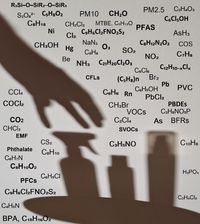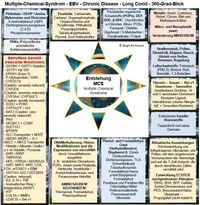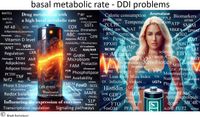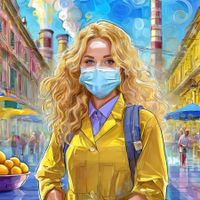The Invisible Danger - Creating Interactive VR Experiences to Raise Awareness About Chemical, Pesticide, and Xenobiotic Exposures
Dear Tech Community, Dear AI Community, Dear Maker Community, Dear Research Institutions and Universities, Dear Technology Companies, Dear NGOs, Dear Authorities Managing Research and Development Funds,
With more than 400 million Long Covid, ME/CFS and MCS sufferers, you are urgently needed on this topic.
We not only need an increase in productivity progress with and through AI (in the area of automation and the like), which is of course very urgent, but we also need your expertise and your innovative inventive spirit for the following topic.
- What do you think about developing AI-supported systems that include professional personalized emergency plans for people with special needs, especially for people with Long COVID, ME/CFS, MCS, infants, toddlers, seniors or neurological disorders?
- Or advanced AI models to monitor disease symptoms and to identify new outbreaks early on, which is especially important for people with Long COVID, ME/CFS and MCS as they have increased sensitivity and specific needs. This could be invaluable for pandemics.
- Or AI models to simulate realistic disaster scenarios and prepare rescue workers for emergencies, especially taking into account the many vulnerable groups (Long COVID, ME/CFS, etc.). This could further improve and enhance the efficiency of rescue strategies.
- Perhaps you could also develop new AI-supported communication platforms that gather and disseminate information in real time to guide all vulnerable target groups to safe escape routes and not only inform them about current dangers but also minimize many risks for them.
- Perhaps you could also develop comprehensive AR-supported training programs that enable rescue workers to practice realistic disaster scenarios. These should also be used for schools and daycare centers, universities, businesses, senior and nursing homes, hospitals, etc., to prepare for emergency situations.
- We also need many more AI-supported systems that can provide psychological support to people in crisis situations, such as chatbots that offer calming and supportive conversations to those affected (many people, especially those with Long COVID, ME/CFS, are still left to fend for themselves).
- Please also develop immersive and interactive VR experiences to make the invisible dangers of chemicals, pesticides, and xenobiotics in our everyday environments finally visible. We must make the invisible dangers of chemical, pesticide, and xenobiotic contamination in our daily environments much more visible and massively raise public awareness through immersive and interactive VR experiences. Users should be provided with concrete and actionable information to protect their health and that of their families. There are certainly a few solutions on the market, but unfortunately, these are far from sufficient and currently fall short. AI algorithms could analyze vast amounts of data to identify patterns and correlations indicating dangerous chemical and pesticide contamination. AI models could be used to simulate the spread of chemicals and pesticides in different environments. These models could then predict how these substances behave under various conditions, thus helping to develop preventive measures. Based on the collected data and individual health profiles, AI systems could send personalized warnings and recommendations to users. For example, someone particularly sensitive to certain chemicals (MCS, ME/CFS, Long Covid patients) could receive an alert when the contamination in their environment increases. AI can be integrated into monitoring systems to continuously monitor air and water quality. Such systems could then automatically sound an alarm when dangerous concentrations of chemicals or pesticides are detected.
As you can see, there is a lot to develop and advance in the field of AI ...
We are facing enormous challenges worldwide, and your technical know-how and inventive spirit represent such an important (additional) key to making all these vulnerable target groups a little more resilient and also a little "healthier." My MindGuardians VR Visionary, Resilient Ranger, and GameMaster have joined me in brainstorming ideas for you and we sincerely hope that you can implement one or two of these ideas.
The first reports of chemical sensitivity date back to 1956. At that time, American allergist Theron G. Randolph defined a range of disorders in his patients after exposure to various and unrelated chemical compounds, which he termed "environmental illness" (1, 2, 3). MCS (Multiple Chemical Sensitivity) is increasingly coming into focus alongside Long Covid, ME/CFS and many neurodegenerative diseases and we can no longer turn a blind eye to this issue. Many millions of people are also following Medical Medium Anthony William for this reason. Ultimately, this topic is closely related to our resilience and prevention.
Unfortunately, this is not a topic for joking around and I see that in my personal environment, more and more people are developing strong sensitivities to chemicals, xenobiotics and other pollutants and are reacting massively. The bodies are weakened further and further and the word resilience is becoming increasingly distant for all of them.
E-book “Moonlight Resilience Compass - Paths to Hope and Strength for Children with Long Covid and ME/CFS (including a Moon Village Concept for Clinics and Rehabilitation Centers” (November 2025)
Problematic Toxicological Basics (4)
- Organic solvents and related compounds
- Organochlorine insecticides / Organophosphates
- Insecticides, pesticides, carbamates and organophosphorus herbicides
- Pyrethroid pesticides
- Carbon monoxide (CO)
- Hydrogen sulfide (H₂S)
- Mercury (in all its chemical forms)
...
Please let me take you into my world of scenarios and possible interactive elements required.
This contribution was written by Birgit Bortoluzzi, the creative founder of the “University of Hope” – an independent knowledge platform with a mission: to make resilience, education, and compassion visible and audible in a complex world.
Source References
(1) Randolph, T. G. (1978) Human Ecology and Susceptibility to the Chemical Environment. Springfield, Ohio: Charles C. Thomas.
(2) Randolph, T. G. (1987) Environmental Medicine: Beginnings and Bibliographies of Clinical Ecology. Clinical Ecology Publications.
(3) Moss, R. W. & Randolph, T. G. (1980) An Alternative Approach to Allergies: The New Field of Clinical Ecology Unravels the Environmental Causes of Mental and Physical Ills. New York: Lippincott & Crowell.
(4) Pall, M. L. (2011) Multiple Chemical Sensitivity: Toxicological Questions and Mechanisms. In: John Wiley & Sons Ltd. (Eds.), General, Applied and Systems Toxicology.




